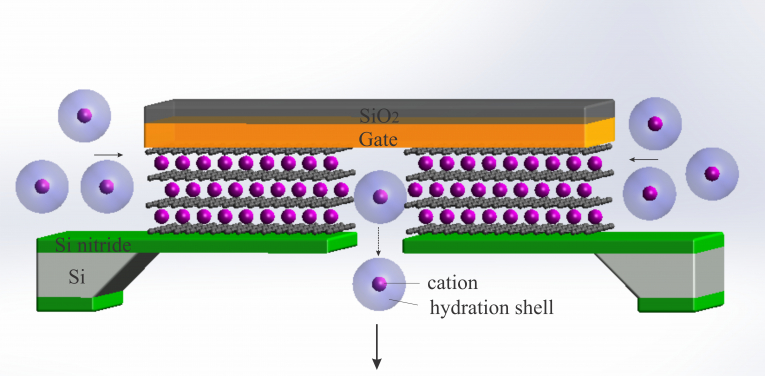Scaling down Ionic Transistors to the ultimate limit
12 May 2021
The human brain is a vast network of billions of biological cells called Neurons which fires electrical signals that process information, resulting in our sense and thoughts. The ion channels of atomic scale in each neuron cell membrane plays a key role in such firings that opens and closes the ion flow in an individual cell by the electrical voltage applied across the cell membrane, acting as a “biological transistor” similar to electronic transistors in computers. For decades, scientists have learned that biological ion channels are life’s transistors capable to gate extremely fast and precisely selective permeation of ions through the atomic-scale selectivity filters to maintain vital living functions. However, it remains a grand challenge to date to produce artificial structures to mimic such biological systems for fundamental understanding and practical applications.
Researchers led by Professor Xiang Zhang, the President of the University of Hong Kong (HKU), have developed an atomic-scale ion transistor based on electrically gated graphene channels of around 3 angstrom width which demonstrated highly selective ion transport. They also found that ions move a hundred times faster in such a tiny channel than they do in bulk water.
This breakthrough, recently reported in Science, not only provides fundamental understanding of fast ion sieving in atomic scale, but also leads to highly switchable ultrafast ion transport that can find important applications in electrochemical and biomedical applications.
“This innovative ion transistor demonstrates electrically switching of ultrafast and simultaneously selective ion transport through atomic-scale channels like biological ion channels functioning in our brain,” said principle investigator Professor Xiang Zhang. “It deepens our fundamental understanding of ion transport at ultrasmall limit and will significantly impact important applications such as sea water desalination and medical dialysis.”
The development of artificial ion channels using traditional pore structures has been hindered by the trade-off between permeability and selectivity for ion transport. Pore sizes exceeding the diameters of hydrated ions render ion selectivity largely vanished. Elevated selectivity of monovalent metal ions can be achieved with precisely controlled channel dimension at the angstrom scale. However, these angstrom-scale channels significantly preclude the fast diffusion due to steric resistance for hydrated ions to enter narrower channel space.
“We observed ultrafast selective ion transport through the atomic scale graphene channel with an effective diffusion coefficient as high as Deff ≈ 2.0´10-7 m2/s.” said study lead author Yahui Xue, a former postdoctoral researcher in Professor Zhang’s group. “To the best of our knowledge, this is the fastest diffusion observed in concentration-driven ion permeation through artificial membranes and even surpasses the intrinsic diffusion coefficient observed in biological channels.”
Scientists from Hong Kong and UC Berkeley first used gate voltage to control the surface potential of graphene channels and realized ultrahigh density of charge packing inside these channels. The neighboring charges exhibit strong electrostatic interaction with each other. This results in a dynamic charging equilibrium state so that the insertion of one charge from one end of the channel would lead to the ejection of another at the other end. The resultant concerted charge movement greatly enhances the overall transport speed and efficiency.
“Our in situ optical measurements revealed a charge density as high as 1.8´1014 /cm2 at the largest applied gate voltage.” said Yang Xia, a former PhD student in Professor Zhang’s group. “It is surprisingly high, and our mean field theoretical modeling suggests the ultrafast ion transport is attributed to highly dense packing of ions and their concerted movement inside the graphene channels.”
The atomic-scale ion transistor has also demonstrated superior switching capability, similar to that in biological channels, originating from a threshold behavior induced by the critical energy barrier for hydrated ion insertion. The smaller channel size than the hydration diameters of alkali metal ions creates an intrinsic energy barrier that forbids ion entry in the open circuit condition. By applying gating electric potential, the hydration shell could be distorted or partially striped off to overcome the ion-entry energy barrier, enabling ion intercalation and eventually permeable ion transport beyond a percolation threshold.
The atomic scale graphene channel was made of a single flake of reduced graphene oxide flake. This configuration has the advantage of intact layer structures for fundamental property investigation and also preserves large flexibility for scaling-up fabrication in the future.
The selection sequence of alkali metal ions through the atomic-scale ion transistor was found to resemble that of biological potassium channels. This also implies a controlling mechanism similar to biological systems, which combines ion dehydration and electrostatic interaction.
This work is a fundamental breakthrough in the study of ion transport through atomic scale solid pores. The integration of the atomic-scale ion transistors into large-scale networks can even make it possible to produce exciting artificial neural systems and even brain-like computers.
Link to the article in Science: https://science.sciencemag.org/content/372/6541/501
Xue, Y.; Xia, Y.; Yang, S.; Alsaid, Y.; Fong, K. Y.; Wang, Y.; Zhang, X., Atomic-scale ion transistor with ultrahigh diffusivity. Science 2021, 372 (6541), 501-503.
For media enquiries, please contact HKU Communications and Public Affairs Office: Ms Melanie Wan, Senior Manager (Media), Tel: 2859 2600 / Email: melwkwan@hku.hk or Ms Rashida Suffiad, Senior Manager (Media), Tel: 2857 8555 / Email: rsuffiad@hku.hk.

